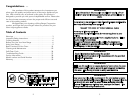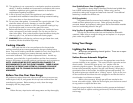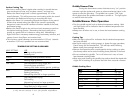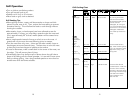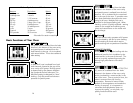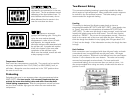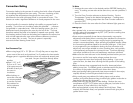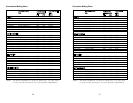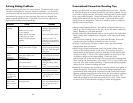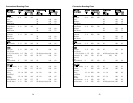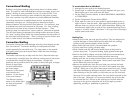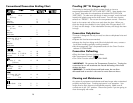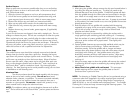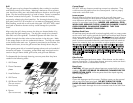
Baking Tips
•As a general rule, to convert conventional recipes to convection
recipes, reduce the temperature by 25
0
F (14
0
C) and the cooking time
by approximately 10 to 15%.
•Some recipes, especially those that are homemade, may require
adjustment and testing when converting from standard to convection
modes. If unsure how to convert a recipe, begin by preparing the
recipe in conventional bake. After achieving acceptable results, follow
the convection guidelines listed for the similar food type. If the food
is not prepared to your satisfaction during the first convection trial,
adjust only one recipe variable at a time (cooking time, rack position,
or temperature) and repeat the convection test. Continue adjusting
one recipe variable at a time until satisfactory results are achieved.
•Make sure the oven racks are in the desired positions before you turn
the oven on and for best results, always preheat the oven.
•Do not open the oven door frequently during baking. If you must
open the door, the best time is during the last quarter of the baking
time.
•Bake to shortest time suggested and check for doneness before
adding more time. For baked goods, a stainless steel knife placed in
the center of the product should come clean when done.
•Use good quality baking pans and sizes recommended in the recipe;
warped, dented, or burned pans should not be used.
•Shiny metal pans are preferred for baking items such as cakes,
cookies, and muffins because they produce light, golden crusts due to
heat being reflected by the metal.
•Glass pans may also be used for cake baking. Reduce the oven
temperature by 25
0
F (14
0
C) when using a glass pan, but bake for the
same amount of time called for in the recipe.
•Pies are best baked in pans which absorb and hold heat. Glass,
enamel, dull-finished metal, and porcelain enamel finish give pies a
golden brown crust.
19
To Bake:
1. Arrange the oven racks in the desired position BEFORE heating the
oven. If cooking on two racks at the same time, use rack positions 3
and 5.
2. Turn the Oven Function selector to desired function. Set the
Temperature Control to the desired temperature. Cooking starts
immediately. Cooking stops when the Oven Function selector is
turned to OFF.
4. Place the food in the oven after the Oven Indicator light goes out.
18
Convection Baking
Convection baking is the process of cooking food with a flow of heated
air circulating throughout the oven cavity. The even circulating of this
air equalizes the temperature throughout the oven cavity and
eliminates the hot and cold spots found in conventional ovens. This
feature can make a significant difference in foods prepared in the oven.
A major benefit of convection baking is the ability to prepare food in
quantity. The uniform air circulation makes this possible . . . a feature
not possible in a standard oven. With this heating system, the air is
distributed evenly throughout the oven by the hot air fan. The heat
therefore reaches the food to be baked or roasted more quickly. With
this heating method, foods can be baked and roasted at the same time
with minimal taste transfer, even when different dishes are involved,
such as cakes, fish, or meat. The hot air system is especially
economical when thawing frozen food.
Pan Placement Tips
•When using large (15” x 13” [38 cm x 33 cm]) flat pans or trays that
cover most of the rack, rack positions 2 or 3 produce the best results.
•Stagger pans in opposite directions when two racks and several pans
are used. No pan should be directly above
another.
•Allow 1 1/2” to 2”
(3.8 cm to 5.1 cm)
of air space around
all sides of each pan
for even air
circulation.
•When baking on
more than one rack,
it is recommended
to use the 3rd and
5th position for
more consistent
even baking.



